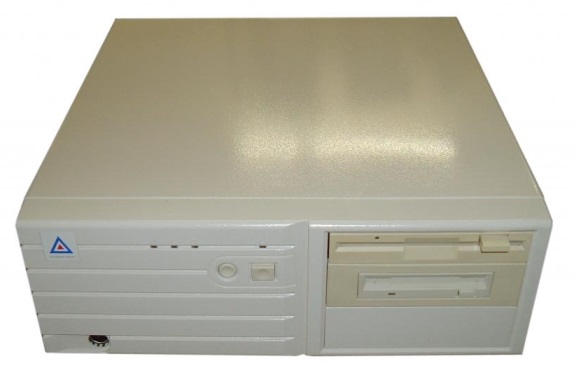
The Spectrum may have been the formative computing experience of my early boyhood but I am, first and foremost, a child of the PC. So here we have part 3 of the series, the early years of the PC where the beeper still held sway. Competing with the might of the Amiga, the PC promised great things…
After the Spectrum came the beige box. With its non-integrated keyboard, a mouse (a what?) and little drive for flimsy-looking floppy disks, it was a far cry from the black beauty I grew up with.
At first I knew nothing about PCs, the hardware or the specifications. Upgrading was something that would come later. For now it was simply a magical device that could do all kinds of crazy things as well as just playing games. A 33MHz 386SX with 512KB of video memory, 4MB of RAM and an entire 40MB of disk space, it was more than enough to play the games of the time. Soundcards and CD drives were a few years from the mainstream yet, so games came measured in megabytes and still relied primarily on the PC speaker for audio. It wasn’t until later when I would discover the joys and fears of upgrading my machine, back when putting in a new processor was an emotional experience that gave you an immediate and noticeable gameplay experience. Being able to actually play some games for the first time. Minimum specs really meant something in those days.
Covering the entirety of my PC-based life in one post would run to thousands of words and, Forth Bridge style, need another chapter by the time it’s done… Therefore, consider this post the MIDI era, with “real” soundcards and CDs making an appearance in the next post.
Like many computers today, early PCs came equipped with an internal speaker – if your computer beeps when it starts up, that’s the internal speaker (the “beeper”). If something has ever gone horribly wrong at startup you’ll remember hearing a cryptic series of beeps – that wasn’t your computer mocking you, they were error codes. After all, the speaker is one of the simplest and most reliable bits of hardware in there – any number of things could happen to stop the screen working, but if it can’t even work the speaker odds on you have a more serious problem than a loose connection or a dodgy hard drive.
The hardware may have changed but the fundamentals have not. The speaker was designed to produce a square wave with two levels of output, driven at just shy of 1,200 kHz. Using tricks like pulse-width modulation engineers and programmers could make that square wave dance, approximating the range of pulse-code modulation – i.e. “real” audio.
Now, this is the point where I realised that I may have been looking back with rose-tinted ears. I would have sworn that my PC had nothing more than a beeper in it, and that it wasn’t until years later when I got a sound card that I got modern sound and music. But no, my computer had, at the very least, something capable of producing MIDI sound, No matter. Let’s have a look and listen at a handful of the games that formed the soundtrack of my childhood…
Lemmings
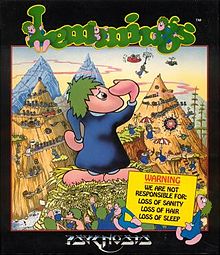 If you’ve never heard of Psygnosis’ Lemmings you’re not only reading the wrong blog, but probably only on the internet by mistake. Released on more or less everything in 1991 it’s gone down as one of the most popular games ever made, and it certainly ate a significant chunk of my life. The music and FX were composed by Brian Johnson (younger brother of one of the developers), and then “de-copyright-issued” by Tim Wright – sampling popular music was still common, but as gaming became more mainstream and profitable, so to did enforcement of intellectual property. This is why the soundtrack consists largely of arrangements of timeless classics like “How Much is that Doggy in the Window”, “London Bridge is Falling Down”, “She’ll be Coming Round the Mountain” and a wonderful range of classical music from Tchaikovsky, Mozart and Chopin, among many others, all rendered as wonderfully charming chiptune masterpieces.
If you’ve never heard of Psygnosis’ Lemmings you’re not only reading the wrong blog, but probably only on the internet by mistake. Released on more or less everything in 1991 it’s gone down as one of the most popular games ever made, and it certainly ate a significant chunk of my life. The music and FX were composed by Brian Johnson (younger brother of one of the developers), and then “de-copyright-issued” by Tim Wright – sampling popular music was still common, but as gaming became more mainstream and profitable, so to did enforcement of intellectual property. This is why the soundtrack consists largely of arrangements of timeless classics like “How Much is that Doggy in the Window”, “London Bridge is Falling Down”, “She’ll be Coming Round the Mountain” and a wonderful range of classical music from Tchaikovsky, Mozart and Chopin, among many others, all rendered as wonderfully charming chiptune masterpieces.
Oh my, that first track… I’m in heaven. Once I got these as MIDI files I just couldn’t hep but listen. It was my first real chiptune fanboy experience – after all, it’s just the Can-Can. Just “London Bridge”. Just “Swan Lake”. Why would I like them so much, if not for the medium and the memories?
Honourable Mention: Cannon Fodder
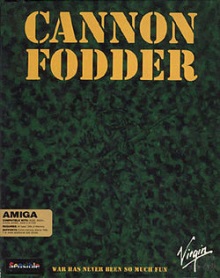 Cannon Fodder was always an Amiga game first and foremost, taking advantage of the platform’s superior music hardware to produce some truly iconic and memorable music. I only ever played it on the PC, though I got to compare it to the version running on a friend’s Amiga (envy!). Having said that, the PC version was no slouch either, and gets an honourable mention for a single track that manages to reflect perfectly the game’s conflicting themes of “war, it’s fantastic” and “war is hell”. This track sums it up perfectly – the recruit selection screen where you have a seemingly endless stream of troops to send into battle, but who you’ll end up caring about. Nobody likes seeing Stoo and Jools biting the dust.
Cannon Fodder was always an Amiga game first and foremost, taking advantage of the platform’s superior music hardware to produce some truly iconic and memorable music. I only ever played it on the PC, though I got to compare it to the version running on a friend’s Amiga (envy!). Having said that, the PC version was no slouch either, and gets an honourable mention for a single track that manages to reflect perfectly the game’s conflicting themes of “war, it’s fantastic” and “war is hell”. This track sums it up perfectly – the recruit selection screen where you have a seemingly endless stream of troops to send into battle, but who you’ll end up caring about. Nobody likes seeing Stoo and Jools biting the dust.
Monkey Island 2
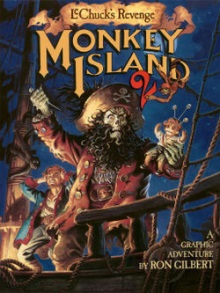 Saving the best to last…
Saving the best to last…
I’m slightly embarrassed to say that I never played most LucasArts adventure games despite being a massive fan of the genre in general and the studio in particular. I did however play Monkey Island 2: LeChuck’s Revenge and, alongside Day of the Tentacle, it’s probably the zenith of PC adventure gaming – not to mention sheer comedy.
Monkey Island 2 was the first game to feature the iMUSE (Interactive Music Streaming Engine) system, which synchronizes music with the action and gameplay, resulting in a much deeper sense of immersion and a connection between music and story that had previously been the sole preserve of TV and cinema. It was developed by LucasArts composers Michael Land and Peter McConnell who also produced much of the game’s music. The benefits of handing such control over the music to composers are clear and Monkey Island 2 was praised for how the music added to the atmosphere. More on iMUSE below…
The game supported the internal speaker as well as a number of early sound cards (Sound Blaster, AdLib, etc), and – to quote Wikipedia – “all MIDI files used by the game were recordings of hand-played performances over a MIDI controller, adding to the lively feeling of the soundtrack.”
It was looking up videos for this game that made me realise quite how off-kilter my memories were. To demonstrate the difference between the capabilities of the PC speaker and even the most basic of MIDI systems, let’s compare and contrast. Bear in mind that LucasArts were masters of the PC Speaker…
PC Speaker
https://www.youtube.com/watch?v=KY35VB0b_Y
And the soundtrack in its full glory
Bonus Round! The Special Edition
iMUSE
It’s a way to organize all the different music cues, and see how they relate to each other by using a graphic layout. It also allows the composer to specify transitions and other types of musical responses at a pretty detailed level.
– Michael Land
They say that if while you’re watching a film you notice the soundtrack it isn’t doing its job. A soundtrack is meant to enhance an experience, to help the viewer immerse themselves in it – not to be the experience. Taking this concept and applying it to the medium of video games comes with its own unique set of challenges. Games were still being defined as an art and entertainment platform (they still are, come to that) and composers worked hard to create soundtracks that helped deepen the experience and the immersion. But players though, not viewers, and therein lay the challenge. Only a very few games are so rigidly defined that a score can be put to it perfectly so that a predefined set of tracks perfectly matches the gameplay and the story.
At first, it was trivial – mood music to set the tone in the intro, a little piece to start and end each level, and something to accompany victory or defeat. But when music started to play alongside the action, what then? Take Super Mario Brothers for example. The music starts when the level starts and ends when Mario dies or clears the level. Even for something so simple, there is no guarantee that the death or victory music will line up nicely with the in-game music. They worked around it by having the music stop abruptly, interrupted by an effect (death, flagpole) which makes way for the relevant music. Very neat, it worked beautifully and nobody ever said to themselves “hey, it’s great I won and all, but I hate the way the music cut out”.
But then games got more complicated, and the composers at LucasArts found themselves running up against the limits of how technology could support their vision. With the player so thoroughly in control of the action, the story and – most importantly – the timing, how could they make sure the music matched up to the events on screen? Just stopping and starting, switching and changing as necessary wouldn’t work, it would be jarring and noticeable. Perhaps no other studio would have cared (maybe the fact that LucasArts did this first meant that nobody else did?) But Land and hos cohorts cared enough to develop and patent the technology they would need. iMUSE was introduced with Monkey Island 2 and was so successful it was used in every LucasArts adventure game since as well as a number of LucasArts’ Star Wars games. Over time it would evolve beyond MIDI into the digital age, but its first outing was certainly a memorable one, made all the more amazing by the fact that the number of people who consciously noticed was effectively zero. All they knew was that there was a great soundtrack and an immersive story that people found intensely engaging. Thanks, in no small part, to iMUSE.
iMUSE had a number of tricks up its sleeve. It could gracefully fade out a track, or crossfade to another, melding scores together convincingly. It could intelligently end tunes to coincide with the events on screen, layer in new instruments or motifs to gradually draw the player in or change the ambience without anything so crude as starting a new – if similar – track. It could even be used to inform in-game events so they coincided with the proper point in the music. Let’s have a look at iMUSE in action:
For a more detailed description of iMUSE in its original MIDI form and more recent digital incarnation, go read Dramatic Genius: LucasArts and iMUSE. It has a single – if remarkable – example of iMUSE in Monkey Island 2 and some fascinating descriptions of its application in other Monkey Island games.
Like countless others you may never have noticed iMUSE subtly orchestrating your gaming experience. I certainly didn’t. But it’s fair to say that thanks to the brilliant work of the LucasArts team iMUSE raised the bar for video game music and gaming immersion. A bar that, thankfully, has continued to be raised to this day.
So, MIDI…
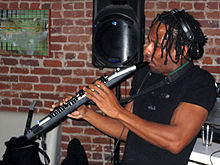 MIDI is one of those things I’ve always had a vague understanding of. I know without checking, for example, that it stands for Musical Instrument Digital Interface, and that if I had to describe it to a stranger it would be – in this context – using instrument synthesis to produce semi-realistic music from very compact files.
MIDI is one of those things I’ve always had a vague understanding of. I know without checking, for example, that it stands for Musical Instrument Digital Interface, and that if I had to describe it to a stranger it would be – in this context – using instrument synthesis to produce semi-realistic music from very compact files.
MIDI has a whole history in the audio industry, leading back to the early 80s when it was standardized. Since a MIDI file is essentially “a spreadsheet-like set of instructions” (Wiki again, yes I’m shameless) it is compact and an be edited in a variety of ways. You can have a full studio where controllers are actually laid out like real instruments (e.g. drum kits, keyboards) and the act of playing them directly creates the MIDI data; a simple computer interface where scores are laid out by hand – composition with real-time creation and feedback; even algorithmic music – computers creating art.
As mentioned in previous posts, composers working with the simple audio hardware found in the Spectrum and its ilk would often compose in MIDI, or work from existing MIDI data, then work to achieve the same sound using the hardware available. The first Monkey Island video above shows how, erm, close you can get.
MIDI in games
In the 90s MIDI was perfect for gaming. Games were then limited by the size of the media on which they were distributed – the 1.44MB floppy disk. Even with low-quality encoding, a floppy would only hold a few minutes of music in a format like MP3 before running out of room – ignoring the fact that a 386 would cry tears of shame if asked to decode an MP3. Wave files require an order of magnitude more space, so if you wanted more than a few seconds of music, but also wanted to do better than the speaker, MIDI was your best friend. Taking advantage of the small file size, vast range of possible sounds and the widely supported standard, MIDI allowed game studios to add full-length, high quality soundtracks to their games without choking on space.
The only problem with this was that the quality of MIDI output was purely dependent on the hardware doing the decoding and playback. If the hardware’s instrument samples were poor, or didn’t match the standard, you could have a very low quality of sound. Even ignoring quality, two good quality sound cards could and would produce noticeably different sounds. This all served to give MIDI the air of being low quality, when in fact by its very nature, it had no quality whatsoever. Even so, it was rapidly phased out by the arrival of CDs and larger hard drives. Depending on whether you disliked it for the unrealistic instrument reproduction, or enjoyed it for essentially the same reason, MIDI in gaming is either best left behind or sadly missed. No prizes for guessing I sit firmly in the latter camp.
So, on that sad note, I leave you with a track from an unsung classic as heard through a superb piece of kit. Ladies and gentlemen, the Roland SC 88 showing just what MIDI can do:
[15 July 2013: I fleshed out the iMUSE section because quite frankly it warranted more than a single paragraph]

